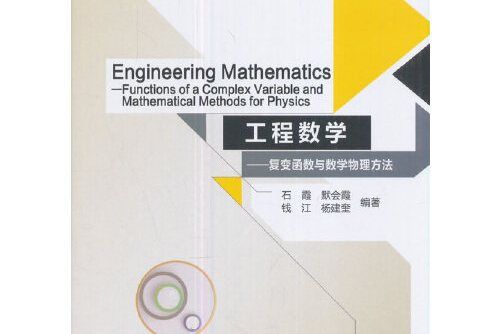《工程數學——複變函數與數學物理方法》是2017年北京郵電大學出版社出版的圖書。作者是石霞,默會霞,錢江,楊建奎。本書可作為理工科院校非數學專業本科生的雙語教材,也可供有關工程技術人員參考。
基本介紹
- 中文名:工程數學——複變函數與數學物理方法
- 作者:石霞、默會霞、錢江、楊建奎
- 出版社:北京郵電大學出版社
- ISBN:9787563552641
內容簡介,圖書目錄,
內容簡介
《工程數學:複變函數與數學物理方法(英文版)/普通高等教育“十三五”規劃教材》是一本用於同名課程雙語教學的英文教材,編者按照國家教育部對本課程的基本要求,參考了多本有關的英文教材,結合多年的教學實踐編著而成。《工程數學:複變函數與數學物理方法(英文版)/普通高等教育“十三五”規劃教材》包含複變函數和數學物理方法兩部分。複變函數部分的內容包括:複數與複變函數的基本概念、複變函數的導數和積分、解析函式的定義和性質、解析函式的冪級數表示、留數定理及其套用等。數學物理方法部分的內容包括:三類典型方程的導出和定解問題的定義、二階線性偏微分方程的分類和化簡以及達朗貝爾公式求解波動方程、分離變數法求解定解問題和特徵值問題、貝塞爾函式和勒讓德多項式、傅立葉變換和拉普拉斯變換。
《工程數學:複變函數與數學物理方法(英文版)/普通高等教育“十三五”規劃教材》可作為理工科院校非數學專業本科生的雙語教材,也可供有關工程技術人員參考。
圖書目錄
Part Ⅰ Functions of a Complex Variable
Chapter 1 Complex Numbers and Complex Functions
1.1 Complex number and its operations
1.1.1 Complex number and its expression
1.1.2 The operations of complex numbers
1.1.3 Regions in the complex plane
Exercises 1.1
1.2 Functions of a complex variable
1.2.1 Definition of function of a complex variable
1.2.2 Complex mappings
Exercises 1.2
1.3 Limit and continuity of a complex function
1.3.1 Limit of a complex function
1.3.2 Continuity of a complex function
Exercises 1.3
Chapter 2 Analytic Functions
2.1 Derivatives of complex functions
2.1.1 Derivatives
2.1.2 Some properties of derivatives
2.1.3 A necessary condition on differentiability
2.1.4 Sufficient conditions on differentiability
Exercises 2.1
2.2 Analytic functions
2.2.1 Analytic functions
2.2.2 Harmonic functions
Exercises 2.2
2.3 Elementary functions
2.3.1 Exponential functions
2.3.2 Logarithmic functions
2.3.3 Complex exponents
2.3.4 Trigonometric functions
2.3.5 Hyperbolic functions
2.3.6 Inverse trigonometric and hyperbolic functions
Exercises 2.3
Chapter 3 Integral of Complex Function
3.1 Derivatives and definite integrals of functions w(t)
3.1.1 Derivatives of functions w(t)
3.1.2 Definite integrals of functions w(t)
Exercises 3.1
3.2 Contour integral
3.2.1 Contour
3.2.2 Definition of contour integra
3.2.3 Antiderivatives
Exercises 3.2
3.3 Cauchy integral theorem
3.3.1 CauchyGoursat theorem
3.3.2 Simply and multiply connected domains
Exercises 3.3
3.4 Cauchy integral formula and derivatives of analytic functions
3.4.1 Cauchy integral formula
3.4.2 Higherorder derivatives formula of analytic functions
Exercises 3.4
Chapter 4 Complex Series
4.1 Complex series and its convergence
4.1.1 Complex sequences and its convergence
4.1.2 Complex series and its convergence
Exercises 4.1
4.2 Power series
4.2.1 The definition of power series
4.2.2 The convergence of power series
4.2.3 The operations of power series
Exercises 4.2
4.3 Taylor series
4.3.1 Taylor's theorem
4.3.2 Taylor expansions of analytic functions
Exercises 4.3
4.4 Laurent series
4.4.1 Laurent's theorem
4.4.2 Laurent series expansion of analytic functions
Exercises 4.4
Chapter 5 Residues and Its Application
5.1 Three types of isolated singular points
Exercises 5.1
5.2 Residues and Cauchy's residue theorem
Exercises 5.2
5.3 Application of residues on definite integrals
5.3.1 Improper integrals
5.3.2 Improper integrals involving sines and cosines
5.3.3 Integrals on [0,2穡? involving sines and cosines
Exercises 5.3
Part Ⅱ Mathematical Methods for Physics
Chapter 6 Equations of Mathematical Physics and
Problems for Defining Solutions
6.1 Basic concept and definition
6.1.1 Basic concept
6.1.2 Linear operator and linear composition
6.1.3 Calculation rule of operator
6.2 Three typical
Partial differential equations and problems for defining solutions
6.2.1 Wave equations and physical derivations
6.2.2 Heat (conduction) equations and physical derivations
6.2.3 Laplace equations and physical derivations
6.3 Wellposed problem
6.3.1 Initial conditions
6.3.2 Boundary conditions
Chapter 7 Classification and Simplification for Linear Second Order PDEs
7.1 Classification of linear second order
Partial differential equations with two
variables
Exercises 7.1
7.2 Simplification to standard forms
Exercises 7.2
Chapter 8 Integral Method on Characteristics
8.1 D'Alembert formula for one dimensional infinite string oscillation
Exercises 8.1
8.2 Small oscillations of semiinfinite string with rigidly fixed or free ends, method
of prolongation
Exercises 8.2
8.3 Integral method on characteristics for other second order PDEs, some examples162
Exercises 8.3
Chapter 9 The Method of Separation of Variables on Finite Region
9.1 Separation of variables for (1 1)dimensional homogeneous equations
9.1.1 Separation of variables for wave equation on finite region
9.1.2 Separation of variables for heat equation on finite region
Exercises 9.1
9.2 Separation of variables for 2dimensional Laplace equations
9.2.1 Laplace equation with rectangular boundary
9.2.2 Laplace equation with circular boundary
Exercises 9.2
9.3 Nonhomogeneous equations and nonhomogeneous boundary conditions
Exercises 9.3
9.4 SturmLiouville eigenvalue problem
Exercises 9.4
Chapter 10 Special Functions
10.1 Bessel function
10.1.1 Introduction to the Bessel equation
10.1.2 The solution of the Bessel equation
10.1.3 The recurrence formula of the Bessel function
10.1.4 The properties of the Bessel function
10.1.5 Application of Bessel function
Exercises 10.1
10.2 Legendre polynomial
10.2.1 Introduction of the Legendre equation
10.2.2 The solution of the Legendre equation
10.2.3 The properties of the Legendre polynomial and recurrence formula
10.2.4 Application of Legendre polynomial
Exercises 10.2
Chapter 11 Integral Transformations
11.1 Fourier integral transformation
11.1.1 Definition of Fourier integral transformation
11.1.2 The properties of Fourier integral transformation
11.1.3 Convolution and its Fourier transformation
11.1.4 Application of Fourier integral transformation
Exercises 11.1
11.2 Laplace integral transformation
11.2.1 Definition of Laplace transformation
11.2.2 Properties of Laplace transformation
11.2.3 Convolution and its Laplace transformation
11.2.4 Application of Laplace integral transformation
Exercises 11.2
References

